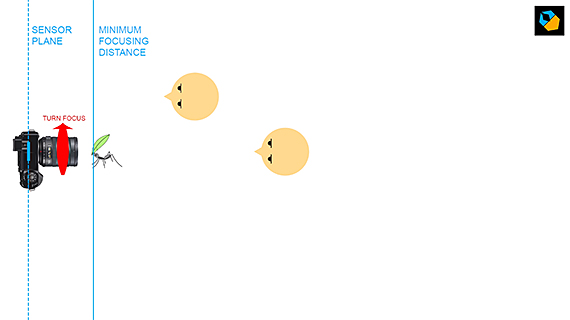Do you ever notice the background in a scene when watching a TV show or movie? Do you notice when it’s in focus or out of focus? Try to look out for that next time you’re watching something. Same with photography—sometimes the background of a photo is just a big blur, while other times it’s completely in focus. This is a totally planned design element by the photographer or cinematographer, and it’s called Depth of Field. In this wolfcrow video, Sareesh Sudhakaran explains what shallow and deep depth of fields are and when you should use each:
Depth of Field in a Nutshell
Whenever you focus your lens on something, there’s always a bit of space before and after the object in focus that’s also “acceptably in focus.”
You’ve essentially focused on a plane, and how you adjust your focus ring moves that plane closer or further away. When you want to focus on something up close, you turn your focus ring and the plane moves closer to you.
There is a minimum focusing distance, but macro lenses will allow you to get even closer. Same thing for focusing far away. If you set your lens to infinity focus, everything beyond that point will be in focus; that’s the furthest you can go.
Now, here’s the thing: no matter how much you focus, nothing is ever point sharp. It may look absolutely perfect, but the image of the point on the lens will actually be a bit blurry around the edges; it’s a gradient that fades away. Our eyes are a bit forgiving, however, so the point appears to be more in focus.
If you add in more points along the same line of the main focus point, the ones before and after are going to be a litter bit blurrier. But, because our eyes are forgiving, we can accept a certain amount of blurriness—this is the part of the scene that is “acceptably in focus.”
That range where everything appears to be in focus—the distance from the nearest point to the farthest point—is called the Depth of Field.
Shallow Depth of Field and Deep Depth of Field
When the depth of field is small, or shallow, the image background and foreground are blurred, with only a small area in focus. A wider, or deep, depth of field keeps most of the scene in focus. Of course, you can adjust the amount of blurriness or sharpness in the whole scene.
This is how it’s possible to get a sharp image of a person’s face, for example. Since there’s always some part of the scene before and after the focus plane that appears acceptably in focus, we can adjust and control the depth of field to sharpen the features. If the depth of field is too small and you focus on the eyes, the nose and ears will be out of focus. But, if you widen the depth of field, all the features will look in focus.
The way to increase or decrease the depth of field is by adjusting the aperture. By opening up the aperture, you make the field smaller; and when you stop down the aperture, you widen that field.
An aperture of f/2 will give you a blurry background—a shallow depth of field, while f/22 will show everything in focus—a deep focus. As you move through the apertures, you will see different degrees of blurriness/sharpness, so you can control how you want the image to look.


When to Use Shallow vs. Deep Depth of Field
- Shallow depth of field isolates objects from the background, so the viewer really only sees the main subject. You would use this if the background is not important or if it’s boring and doesn’t provide any benefits to the image.
- If you’re shooting landscapes, however, you want a deep depth of field. If there’s an interesting background that contributes to the shot, you want it in focus.
- But, sometimes you don’t need either extreme. It’s up to you how you want your image to look, so you can adjust the aperture anywhere in between.
Like This Article?
Don't Miss The Next One!
Join over 100,000 photographers of all experience levels who receive our free photography tips and articles to stay current:










Leave a Reply